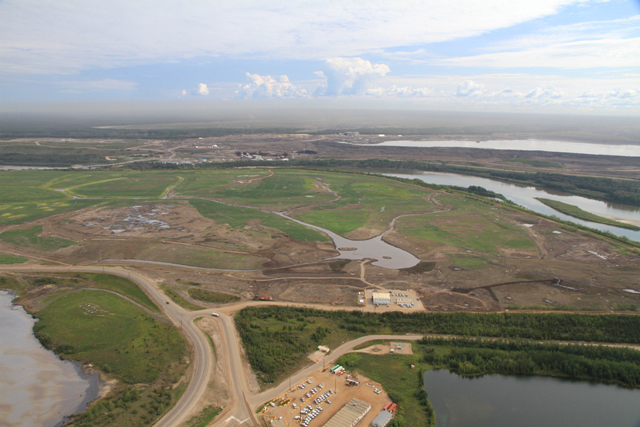
Wildfires continue to rage, but major oilsands sites may escape the flames
by Lauren Krugel, The Canadian Press

Notley hopes to return some residents to their homes by June 1, as insurers expect wildfire to become the costliest natural disaster in Canadian history

Experts say the major oilsands facilities outside Fort McMurray have built-in fire protection and are unlikely to take a direct hit from the wildfires. PHOTO: Suncor Energy Inc.
CALGARY—Wildfires that ravaged some neighbourhoods in Fort McMurray and forced 80,000 to flee the city two weeks ago continue to skirt the Saskatchewan border as they chew through hundreds of thousands of hectares of wilderness where major oilsands projects are located.
As Premier Rachel Notley announced plans to return some residents of the Northern Alberta city to their homes by June 1—so long as it’s safe and the city’s infrastructure allows for it—facilities across Canada’s famed oil-producing region remain under constant threat. A 665-unit work lodge burned down earlier this week and two more are endangered. Still, experts and officials say they aren’t expecting serious harm to the oil-producing facilities themselves.
Here’s why:
There’s a built-in buffer zone:
Oilsands projects—whether they involve scooping the ore out of a mine or melting it underground with steam—are built in such a way that there’s a lot of empty space between facilities and forest. Unlike in residential neighbourhoods where there are a lot of trees and wooden buildings, there’s little in the way of fuel at the industrial sites to feed the ravenous flames. “There’s an inherent built-in safety space around all these facilities,” said Robert Bedin, with RS Energy Group in Calgary. Alberta wildfire manager Chad Morrison told reporters that because vegetation has been cleared away and the ground is covered in gravel, “we feel fairly confident that the sites themselves will be OK.”
Bitumen doesn’t catch fire easily:
Morrison battled wildfires in oilsands country in 2011. Burning bitumen, the tarry product extracted at the sites, wasn’t an issue then and it’s not expected to be one this time either, he said. Bitumen has more in common with crumbly asphalt than highly combustible gasoline, said Bedin. “It’s not volatile. It’s pretty benign. So in most scenarios I think we’re talking about, this stuff is not likely to ignite,” said Bedin. Fire needs oxygen to grow, and there’s no way for it to get into the oil-soaked sand and clay, said Raj Mehta, a professor of oil and gas engineering at the University of Calgary. “It will burn momentarily, but after that it will die.”
Ditto, tailings ponds:
Tailings ponds hold the waste product that’s left over from the oilsands extraction process—and they’re huge. The ponds contain used water, sand, clay and residual bitumen. But the amount of bitumen is too small to pose a danger, Mehta said. “I think that’s the biggest myth people worry about,” he said. “Lots of people think that this whole lake, huge lake, is going to catch fire—no. The answer is no.”
The stuff that could catch fire or explode is mostly underground:
Oilsands projects rely heavily on natural gas to generate power for their plants and heat up the steam that’s used to liquefy the bitumen in some projects. They also need diluent, a very light petroleum product, to make the tarry oilsands crude thin enough to flow through pipelines. Both are products one would want to keep as far away as possible from the encroaching flames. Fortunately, the pipes that carry those substances are buried underground, Mehta said.
Meanwhile, the enormous cost of the disaster has the head of the Insurance Bureau of Canada calling for city planners to reassess where they build.

The wildfire is expected to become the costliest natural disaster in Canadian history. PHOTO: jasonwoodhead23, via Flickr
Too many cities have allowed homes and facilities to be built in areas where they could be destroyed by floods or fire, Don Forgeron, the organization’s president and CEO, said.
Forgeron expects the fire will be the costliest natural disaster in Canadian history, racking up somewhere between $3 billion and $9 billion in insurance costs. He said it is unlikely that insurance premiums across the country will go up as a result of the fire and that it’s too early to say what will happen to rates in Alberta.
“We’ve let far too many people build in far too many of these areas without any thought whatsoever to what happens,” Forgeron said following a luncheon talk about adapting to climate change.
“If we’re going to build in those areas—and I understand the pressures that some of our municipalities are (under)—you have to make sure that you take appropriate steps to mitigate that risk and eradicate that risk before you allow those developments to take place.”
Forgeron said the federal government needs to strategically invest the green infrastructure money it has set aside in the budget to help communities combat the effects of climate change and reduce disaster-relief payments to provinces.
—With files from Jordan Press and Chris Purdy of The Canadian Press